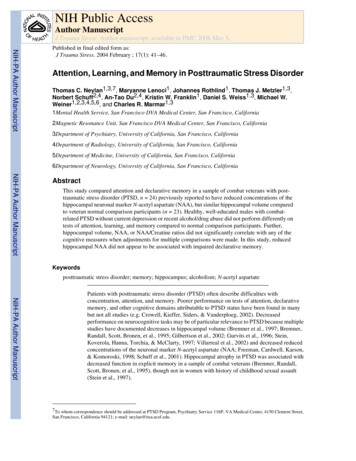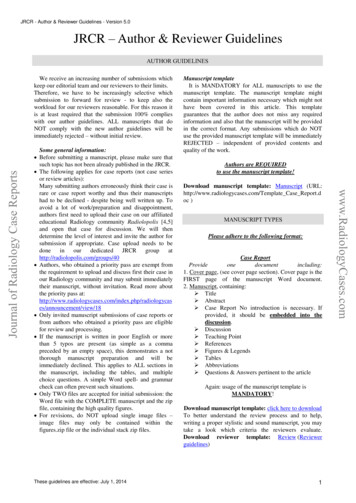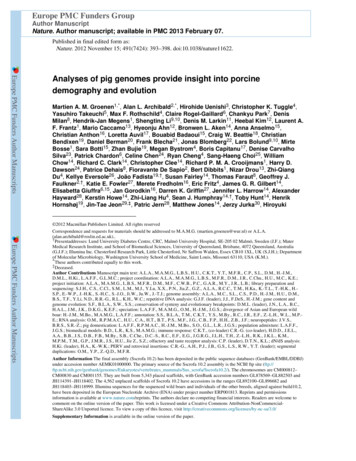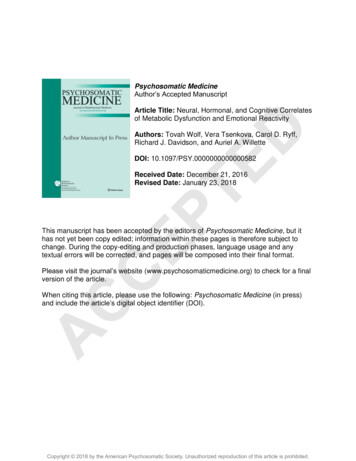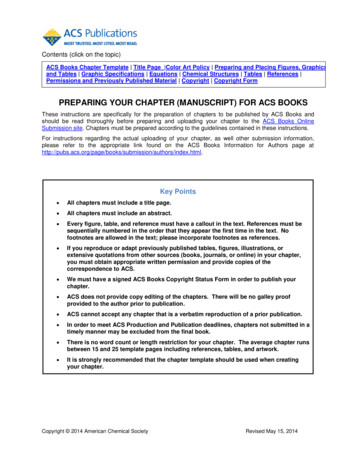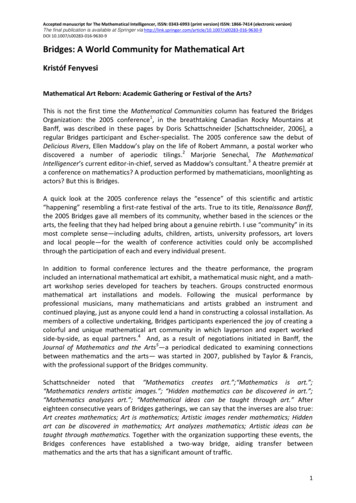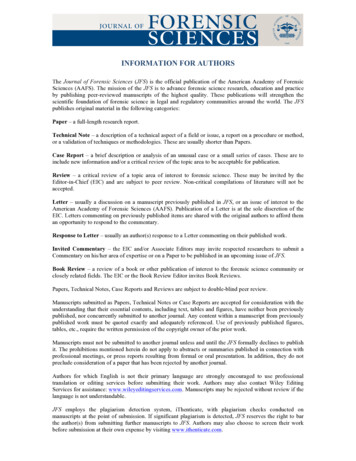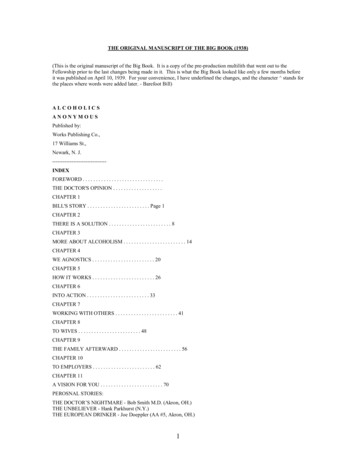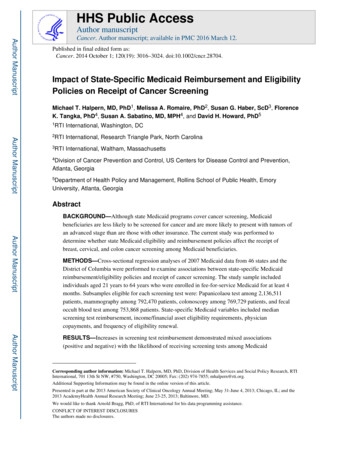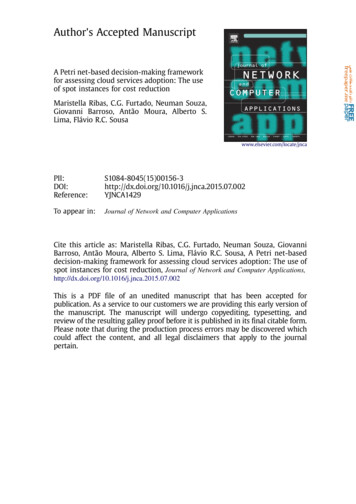
Transcription
Author's Accepted ManuscriptA Petri net-based decision-making frameworkfor assessing cloud services adoption: The useof spot instances for cost reductionMaristella Ribas, C.G. Furtado, Neuman Souza,Giovanni Barroso, Antão Moura, Alberto S.Lima, Flávio R.C. jnca.2015.07.002YJNCA1429To appear in:Journal of Network and Computer ApplicationsCite this article as: Maristella Ribas, C.G. Furtado, Neuman Souza, GiovanniBarroso, Antão Moura, Alberto S. Lima, Flávio R.C. Sousa, A Petri net-baseddecision-making framework for assessing cloud services adoption: The use ofspot instances for cost reduction, Journal of Network and Computer .07.002This is a PDF file of an unedited manuscript that has been accepted forpublication. As a service to our customers we are providing this early version ofthe manuscript. The manuscript will undergo copyediting, typesetting, andreview of the resulting galley proof before it is published in its final citable form.Please note that during the production process errors may be discovered whichcould affect the content, and all legal disclaimers that apply to the journalpertain.
A Petri net-based decision-making framework for assessing cloudservices adoption: The use of spot instances for cost reductionAuthor1 (corresponding author):Name: Maristella RibasAddress: Rua Francisco Teixeira Alcantara, 500 Fortaleza, Brasil CEP 60182360Email: mari@techne.com.brAuthor 2Name: Corneli Gomes Furtado JúniorAddress: Rua Juvenal Galeno, 722 - Benfica - Cep 60015-340Email: cjunior@ifce.edu.brAuthor 3Name: José Neuman de SouzaAddress: UFC-DC-Campus do Pici - Bloco 910 - 60440-504 - Fortaleza - CEEmail: neuman@ufc.brAuthor 4Name: Giovani Cordeiro BarrosoAddress: Rua Princesa Isabel, 1618/101 CEP: 60.015-061 Fortaleza-Ce, BREmail: gcb@fisica.ufc.brAuthor 5Name: J. Antao B. MouraAddress: Av. Aprigio Velloso 882 Bloco CN Sala 210 CEP 58429-140 Campina Grande, PB, BrasilEmail: antao@dsc.ufcg.edu.brAuthor 6: Alberto Sampaio LimaAddress: Rua Bento Albuquerque, 550 Apto 300 - Coco - Cep 60192-060 Fortaleza - Ceara - BrazilEmail: albertosampaio@ufc.brAuthor 7Name: Flávio R. C. SousaAddress: Rua Bento Albuquerque, 550 Apto 550 - Coco - Cep 60192-060 Fortaleza - Ceara - BrazilEmail: flaviosousa@ufc.br
A Petri net-based decision-making framework for assessing cloudservices adoption: The use of spot instances for cost reductionMaristella Ribasa, C. G. Furtadob, Neuman Souzac, Giovanni Barrosoc, Antão Mourad, AlbertoS. Limac, Flávio R. C. SousacaTechne Engenharia e Sistemas, São Paulo, BrazilFederal Institute of Ceará (IFCE), Fortaleza, BrazilcFederal University of Ceará, Fortaleza, BrazildFederal University of Campina Grande, C. Grande, Brazilmari@techne.com.br, neuman@ufc.br, cjunior@ifce.edu.br, gcb@fisica.ufc.br, antao@dsc.ufcg.edu.br,albertosampaio@ufc.br, flaviosousa@ufc.brbAbstractCloud services are widely used nowadays, especially in Infrastructure as a service (IaaS), with vendorsoffering several purchasing options and expanding the range of services offered on almost a daily basis. Costreduction is a major factor promoting the adoption of cloud services among enterprises. However, qualitativefactors need to be evaluated as well, thus rendering the decision regarding the adoption of cloud servicesamong enterprises a non-trivial task for Information Technology (IT) managers. In this paper, we propose aplace/transition or Petri net-based multi-criteria decision-making (MCDM) framework to assess a cloudservice in comparison with a similar on-premises service. The framework helps IT managers choose betweentwo such options, and can be used for any type of cloud service: Infrastructure as a Service (IaaS), Platform asa service (PaaS), Software as a service (SaaS), etc. Because its low cost is among the most important reasonsfor adopting cloud services, we also propose a Petri net to model cost savings using the spot instancespurchasing option in public clouds. Through simulation of several scenarios, we conclude that spot instancespresent a very interesting cost-saving option in the auto-scaling process, even for simple business applicationsusing few servers.Keywords—Cloud computing, Spot instances, BDIM, AHP, Petri nets.1. IntroductionCloud computing is defined by the National Institute of Standard and Technology (National Instituteof Standards and Technology, 2009) as a “model for enabling on-demand network access to a shared poolof configurable computing resources (e.g., networks, servers, storage, applications, and services) that canbe rapidly provisioned and released with minimal management effort or service provider interaction.”Infrastructure as a service (IaaS), Platform as a service (PaaS), and Software as a service (SaaS) arethe classical categories of cloud services, although there are other proposed categories such as Databaseas a Service (DBaaS), Cache as a Service (CaaS), Unified Communications as a Service (UCaaS). In fact,cloud services are becoming so popular that some authors mention the category Everything as a Service(XaaS).One of the many difficult decisions facing Information Technology (IT) managers nowadays is tochoose between adopting an IT service in its cloud model and having the service hosted according to theconventional, on-premises model. The manager has to consider a large number of criteria, with cost beingpossibly the most important one. Cloud services are attractive because of the low-initial investmentinvolved. However, if a cloud service is adopted by an organization, its IT department will no longer haveany control over the infrastructure, and will completely rely upon the fulfillment of the Service-levelAgreement (SLA) clauses in the contract to obtain the required service.In this paper, we aim to shed some light on the business management problem of identifying thefactors and parameters to determine the advantages and disadvantages of using cloud services incomparison with on-premises solutions for enterprise business applications. Furthermore, we focus onmodeling and reducing the cost of the elasticity of cloud services. Also known as dynamic provisioning,elasticity “has become one of the most important features of a cloud computing platform” (Han et al.,2014). By using this feature, application owners can scale up or scale down resources used based on thecomputational demands of their applications, and need to pay only for the resources they actually use.Elasticity poses new challenges to resource management, as pointed in , and makes it more difficult toestimate cost, thus contributing to the greater complexity of the decision-making process.As an example of the above-mentioned decision problem, consider a company that is developing anew platform to offer cloud services for developers of enterprise applications in a PaaS model.
Developers will use PaaS to build and publish their applications. The PaaS provider will be required tohost all applications, and will need the corresponding infrastructure. This infrastructure can be leasedfrom public clouds, fully hosted on premises, or supplied in a hybrid manner, partly on-premises andpartly rented from public clouds. The IT manager must determine the services that the company will hostinternally and those that will be hosted on public clouds in the most cost-efficient manner, all the whileensuring an acceptable quality of service for PaaS clients. There are instances of commercial PaaS thatinternally host their infrastructure (Google, AWS) as well as others that lease public IaaS (Heroku).Hence, the choice of service can be a very difficult decision for the IT manager.In a previous study (Ribas et al., 2014), we proposed an initial version of a framework to supportdecisions on whether to lease cloud services by considering factors related only to SaaS. This initialframework combined several of the most relevant factors for decisions of this type (according to theliterature) and provided an assessment of both options (public clouds and on-premises hosting). Theframework was designed using Petri nets (PNs) in order to benefit from their formal description andprovide a visual interface that is simple, yet powerful enough to perform simulations for differentpurposes. In this paper, we extend the framework to capture cost elements for any type of cloud service,and propose a Petri net model to simulate IaaS utilization and compute cost savings in several scenarios.The PN model used to estimate cost savings uses a particular purchasing option for virtual machines,called spot instances . This purchasing option is currently supported by Amazon Web Services (AWS),the leader in the public IaaS market according to the Gartner Group . Spot instances work in exactly thesame manner as any other Amazon Elastic Compute Cloud (EC2) virtual machine. The difference liesonly in the price scheme: the hourly price for spot instances is not fixed, and clients bid on how muchthey are willing to pay. AWS dynamically defines spot price, which varies in real-time based on supplyand demand. If a client’s bid is higher than the spot price, the spot instance commences. If the spot pricechanges and rises above the client’s bid, the instance is terminated by AWS. In this paper, we refer to anytype of virtual machine that can be rented in a public cloud as an “instance.” Our contributions to theliterature are constituted by: 1) Our proposed framework, where we selected, using recent literature aswell as practical experience, important factors to be considered as well as a reliable method to assess allfactors and provide a simple final score. Moreover, the diagram of the Petri net makes it very easy tounderstand the underlying methodology. 2) The results of simulation scenarios executed whileinvestigating cost reduction through spot prices, where a discount of up to 60% can be obtained without asignificant effort, simply by efficiently using cloud resource purchasing options.The rest of this paper is organized as follows: Section 2 is devoted to a review of related work in theliterature, which provides the parameters need to build the decision-making model. In Section 3, wepresent and discuss the PN model that we constructed to implement our decision-making framework, andprovide an example in Section 4 to explicate our decision-making model. Section 5 contains anintroduction to our PN models built to investigate cost reduction using spot prices, whereas Section 6contains a description of our simulation scenarios, their results, and our discussion. We offer ourconclusions and directions for future research in Section 7.2. Related workThe literature on cloud computing is growing as cloud services are becoming more popular. For asystematic literature review, we searched for the terms “SaaS” and “evaluation,” “evaluating,” or“evaluate” among publications after 2011 on IEEE explore, the ACM digital library, and Science Direct(Elsevier). From the 228 items yielded by the search, we selected 32 papers that seemed relevant to ourstudy. Many of these focused on the evaluation of SaaS strictly from the perspective of technicalperformance. However, our work follows research on business-driven IT management (BDIM) , whichincludes technical as well as business-centric views.A few studies have assessed cloud solutions from the point of view of BDIM. The frameworkproposed in is useful for comparing the cost of IaaS with that of on-premises datacenters. The primitivecognitive network process approach presented in is useful for selecting an offer of service (SaaS) from alist of providers of the same software. The survey in revealed that cost advantages were the strongest andthe most consistent opportunity factor significantly affecting perceived opportunities in SaaS adoption,whereas security risks were the dominant risk factors, followed by performance and economic risks.The study in presented results of a survey conducted in Korea to assess the adoption of SaaS and itsrelated benefit to business, thus confirming the premises of the balanced scorecard (BSC) . The researchin proposed a process based on goal-oriented requirements engineering (GORE) to provide a systematicapproach to evaluate a cloud provider. In , the authors have provided SWOT analysis for the cloudcomputing industry, as well as various issues that will affect stakeholders.
Wu (2011) attempted to develop an explorative model that examined important factors affectingSaaS adoption, such as integrating Technology Acceptance Model (TAM)-related theories with additionalimperative constructs, such as marketing effort, security, and trust. Security is the major risk affectingSaaS adoption according to most researchers (Benlian & Hess, 2011; Wu, 2011a and b; Wu, Lan, & Lee,2011; Bayrak, 2013), whereas cost reduction is the major expected benefit (Benlian & Hess, 2011; Wu,2011; Gupta, Seetharamana, & Raj, 2013; Bayrak, 2013).Other interesting studies of cloud evaluation and adoption relate to pricing schemes , facets ofsecurity in the cloud , selection of cloud providers based on security, and privacy requirements . The costanalysis of on-premises solutions against SaaS solutions was conducted in detail in . In this study, unlikein our framework, the authors did not include qualitative benefits and risks to obtain a final score. Garg,Versteeg, and Buyya (2013) used the analytic hierarchy process (AHP) to combine quality of service(QoS) attributes in order to address the problem of selecting a cloud provider, which differs from ourproblem of comparing on-premises solutions with cloud solutions.We also conducted a search for “cloud cost model” and selected 43 papers relevant to our study. Aninteresting comparison of on-premises services with cloud services was conducted by McGougha et al.(2014). They compared cost and overhead for high-throughput computing (HTC) jobs in twoenvironments: a public cloud and a desktop cluster of non-dedicated resources. Their cloud cost modelconsidered hours of use of instances and upload/download data. They noted that the start of the billingperiod varied among providers. Some, including AWS, charged from the start of the hour within which aninstance was initiated — e.g., billing from 7 pm for an instance initiated at 7:59 pm — whereas otherscharged from the exact time at which the instance was initiated. Their on-premise cost model consideredfactors such as cost of hardware acquisition, cost of technical support for the desktop cluster, chargesincurred for carbon emission, and energy cost (per kWh). They proposed six different cost saving policiesin the cloud: P1, limiting the maximum number of cloud instances, P2, merging different users’ jobs, P3,instance keep-alive to avoid initialization time, P4, delaying the beginning of instances, P5, removing thedelay on starting an instance, and P6, waiting for the start of the next hour.Alfonso et al. (2013) compared the cost of HPC using on-premises services with that using cloud.The simplified cost of the on-premises cluster depended primarily on the purchase of the hardware, themaintenance and operation of the cluster, and its energy consumption (which can be reduced by turningoff idle nodes). For the cloud cost model, they focused on hours of instance use and analyzed factors suchas purchasing options. They proposed an equation to help decide if the option of reserving instances waspreferable for a particular case, assuming one had sufficient information regarding cluster usage rate.Reservation is a purchase option offered by AWS, where one can pay a flat fee in advance and obtain alower hourly rate for instance use. However, as of December 2014, AWS changed the reserved instanceprice model, and hence the equation will need to be updated.Elasticity in multi-tier cloud applications was analyzed by Han et al. (2014). They proposed analgorithm that relied on online monitors to detect changes in workloads and perform correspondingscaling in each tier. The algorithm was designed to measure the cost of adding a server divided by thereduced response time due to this addition. Hence, this criterion is called the consumed cost/decreasedresponse time (CC/DRT) ratio.Some interesting studies investigated cost optimization using linear programming techniques(Malawski et al., 2013) by using Cache as a service (CaaS) to reduce input/output (I/O) costs and improveperformance (Han et al., 2012). Baars et al. (2014) explored factors that affect chargeback for cloudservices, mainly acceptability and effectiveness, and presented interesting insights on qualitative issues incloud service use.Spot instances have been studied (Javadi et al., 2013) through statistical models to characterize theirbehavior. The authors proposed probability density functions (pdfs) for the calculation of spot price andthe interval of price spot change. Another study on spot prices (Tang et al., 2014) proposed a frameworkfor bidding on spot prices in order to achieve monetary advantages, and still comply with SLAregulations.Petri nets were used in (Sousa et al., 2014) as a tool for stochastic generation of dependability andcost models to represent cloud infrastructures.To the best of our knowledge, no study provides a final ranking of cloud services in comparisonwith on-premises solutions considering both cost and other qualitative attributes, including security,which is a major concern. Furthermore, our search of the literature did not yield any study that proposedmodels to estimate cost reduction using spot instances.3. The proposed decision-making framework
We propose a novel framework that combines cost and qualitative issues to produce a final score.We aim to employ a methodology that is simple for managers to visualize and understand (the PN visualgraph is very helpful for that), and one that can be easily adapted to different scenarios. The mechanismof the framework can be divided into three steps:1. Estimate the cost advantage (or disadvantage) of a cloud service over on-premise services2. Evaluate the benefits and risks in a qualitative manner using a multi-criteria decision-making(MCDM) framework, such as AHP.3. Compute the cost/benefit ratio. The option with the highest ratio is better.Figure 1 shows our framework. The left part shows Step 1, cost comparison, whereas the upper rightpart shows Step 2, qualitative evaluation. Step 3 is shown in the lower right part, and contains thefinal output of the model.Figure 1: Proposed CPN multi-criteria decision-making (MCDM) framework.The framework uses colored Petri nets (CPN), an extension of Place-Transition Petri nets, to modelcomplex data types (named colors) and makes use of ML programming. The CPN model contains places,drawn as ellipses or circles, transitions drawn as rectangular boxes, directed arcs connecting places andtransitions, and some textual inscriptions next to the places, transitions, and arcs. In this manner, ourmodel can be summarized in one main graph. The model admits four input parameters — “cost elementscloud,” “cost elements on premises,” “criteria weight,” and “alternatives weight” — and produces twooutputs: “final score cloud” and “final score on premises.” However, in order to completely understandthe model, one needs to understand the colors and functions used. These elements will be discussed as wepresent each step of the framework.3.1 Step 1: Cost estimatesFor cost estimation, the colored Petri nets (CPN) model uses the following elements: Color lc: a list of cost elements. Each cost element is represented by a triplet consisting of threebasic items of information: type of cost (Initial or Annual), name of cost element (e.g., labor,hardware, software), and value in financial terms. As an example, an annual softwaresubscription of 500 can be modeled as (Annual, Subscription, 500). This color is used in the“cost elements cloud” and the “cost elements on premises” parameters
Place Cost Elements Cloud: it contains a list of cost elements to estimate the total cost of thecloud service. This list is one of the input parameters of the model, since it is very specific to theservice. As an example, a list for an SaaS cloud service can be [(Initial, Training, 19.20),(Annual, Salary, 60.00), (Annual, Connectivity, 36.0), (Annual, Subscription, 99.00)].Place Cost Elements OnPremises: it contains a list of cost elements to estimate the total cost forthe service when it is locally operated on premises. This is an input parameter of the model,since it is specific to the service. The “OnPremises” list of cost elements is usually larger, as willbe shown in Section 4.Function initCost(list): it admits a list of costs and returns the sum of all cost elements of typeInitial in order to compute the initial investment necessary to operate the service. This function isused in transitions Cloud Cost and OnPremise Cost.Function annualCost(list): it admits a list of costs and returns the sum of all cost elements oftype Annual in order to compute the annual expenditure required to operate the service. Thisfunction is used in transitions Cloud Cost and OnPremise Cost.Transition Cloud Cost: it computes the initial investment and annual expenditure required tooperate the cloud service. Following computation, the function will set the computed values asmarkings of places “Cloud initial cost” and “Cloud annual cost.”Transition OnPremise Cost: it computes the initial investment and annual expenditure requiredto operate the cloud service. These costs then become the marking of places “OnPremise initialcost” and “OnPremise annual cost.”Cost estimates for IT services, both on-premises and cloud services, can vary significantlydepending upon the application, the size of the enterprise, and the complexity of the enterprise’s businessprocesses . In our previous work (Ribas et al., 2014), we followed Bibi, Katsaros, and Bozanis (2012).Their proposed model addressed initial costs, which are one-time costs, as well as the expected annualdivestment and operational costs. To extend this model to capture all possible cost elements, weintroduced the color set lc, as described previously. Altmann and Kashef (2014) researched cost elementsin recent literature for IaaS cloud services. Table 1 shows a shorter version of the cost factors explored bythem. Since their work is related to hybrid clouds, a few cost factors listed are applicable to public cloudservices, a few are applicable to private cloud services, and some are applicable to both.Table 1: List of cost elements adapted fromCost Type(a) ElectricityCost Elements(a1) Cooling private cloud(a2) Electronic devices (idle)(a3) Electronic devices (in use)(b) Hardware(b1) Server(b2) Network device(c) Software(c1) Basic server software license(c2) Middleware license(c3) Application software license(d) Labor(d1) Software maintenance(d2) Hardware maintenance(d3) Other support(e) Business Premises(e1) Rack, air conditioner(e2) Cabling(e3) Facility(f) Cloud Service(f1) Internet connectivity(f2) Cloud service use(f3) Data transfer to cloud(f4) Data transfer from cloud(f5) Cloud storage
(f6) Data transfer between clouds(g) Deployment(g1) Number of deploymentsOur framework is built in order to easily accommodate any type of pre-computed cost elementfor any type of cloud service.Step 2: Evaluating benefits and risksIn order to assess the benefits and risks, we use AHP , as a classical MCDM method, sincequalitative factors need to be analyzed and AHP has been often used in the literature to evaluate IT andcloud services (Garg, Versteeg, & Buyya, 2013; Yuen, 2012). There are two competing services to beranked: cloud and on-premises. For benefits and risk evaluation, the CPN model uses the followingelements: Color lw: a list of tuples of a string and a real number (criterion, weight), where “criterion”represents the name of the criterion and “weight” is the value assigned to that criterion (e.g., thelist could be [(“strategy,” 0.3), (“quality,” 0.4), (“risk,” 0.3)]. Color la: a list of triples of two strings and a real number (criterion, alternative, weight) where“criterion” represents the name of the criterion, “alternative” the name of the alternative, and“weight” is the value assigned to that criterion for that alternative. (e.g., the list could be[(“strategy,” “cloud,” 0.5), (“strategy,” “onP,” 0.5), (“quality,” “cloud,” 0.5), (“quality,” “onP,”0.5), (“risk,” “cloud,” 0.5), (“risk,” “onP,” 0.5)] Color qual: a pair of real numbers (qc, qo) representing the qualitative evaluation of the cloudservice (qc) and the on-premise service (qo). Place Qualitative Evaluation is of this color. Place Criteria weight holds a list of criteria and their precomputed weights. This is an inputparameter to the framework. In Section 4, we will exemplify qualitative criteria commonlymentioned in the literature. Place Alternative weight: holds a list of weights assigned to the criterion in question for eachalternative to be used in AHP methods. This is also an input parameter to the framework. Transition MCDM: computes the final ranking based on the weight of each criterion using afunction (calcAHP) to perform the necessary calculations. Function calcAHP (lw, la): takes the list of criteria weights and alternative weights, andcomputes final scores for each alternative. In our framework, this function implements the AHPmethod, but it can be customized to use another method for multi-criteria decision making, e.g.,the primitive cognitive network , as long as the function returns a pair of real numbers (qc, qo) torepresent the qualitative evaluation of cloud and on-premises services. Place Qualitative Evaluation: contains the result of the qualitative evaluation returned byfunction calcAHP.Step 3: Compute cost/benefit ratioThe last step of the framework normalizes the costs computed in Step 1 and computes abenefit/cost ratio that ranks the alternatives. For this step, the CPN model uses the following elements: Color scores: a list of real numbers to hold final scores for each alternative. The use of the listallows the framework to produce several evaluations for each alternative. In our example inSection 4, we will compute scores for one-year and five-year analyses for each alternative. Transition Normalize and Compute: takes cost estimates (initial and annual) for cloud servicesand on-premises services as well as the qualitative evaluation for both, and generates the finalscore. For this, it uses two customizable functions, ScoresCloud and ScoresOnP. Function ScoresCloud: computes a score based on user-defined techniques. In our example inSection 4, we implement these functions to compute the total cost of ownership (TCO) for oneyear use and five-year use following . We then normalize to obtain values between 0 and 1, andcompute the cost/benefit ratio of using each service for one and five years, as shown in Figure 2.This example function can be replaced by methods that include more complex financialcalculations to handle depreciation costs, for instance. Function ScoresOnP: similar to ScoresCloud, and is used to compute cost/benefit ratio for onpremise services
Figure 2: User-defined ScoresCloudCloud function.function4. An Illustrative exampleIn order to elaborate on the decision-makingdecisionscenario, we used the problem presented in (Ribas etal., 2014), where a private school with 2,000 students needs toto upgrade its academic managementsoftware. The current software was purchased when the school was much smaller,smaller, and has been renderedobsolete with the advent of new mobile technologies. The current software uses two servers, one for theWeb and the other for the database. These two servers also need to be replaced due to technical problems.The IT manager, after careful research, decides to buy a new software, SCHOOL1, with two deploymentoptions:1) On-premisespremises option: Perpetual license, wherebywhere the school will have to pay an initial licensing feeof R 145,000 (Brazilian reais - value for up to 2,500 students). There is also an optional annualmaintenance fee of R 29,000 29,000 for technical support and software upgrades. An IT infrastructure is neededto install and run the software.2) SaaS option: Annual subscription of R 99,000 99,000 (value for up to 2,500 students, which includestechnical support and software upgrades), whereby the school will be able to access the software using aWeb browser. Moreover, the vendor will sign ana SLA to ensure a certain level of service for availability,performance, and security.In both the two above options, the vendor recommends a training package that enables IT personneland power users to customize the software to meet the school’s requirements in order to ensuresure that userscan operate the software in the most adequate and efficient manner. In the on-premisespremises option, it isnecessary to purchase two physical hosts (or a corresponding virtual solution) for the database and theWebeb servers. Software licenses for a Windows Server and Microsoft SQL Server would be required aswell. We estimated the annual salary of two IT professionals to be R 60,000 60,000 each. Internet costs wereestimated to be R 24,000 24,000 and energy at R 3,600 per year. For the SaaS option, the training prices are thesame, but the cost of service is 10% lower because there is no installation cost. Internet costs are higherthan the on-premise option at R 36,000. 36,000. However, expenditure on salaries will decrease because only oneIT person will be required.Table 2: Lists of cost elements (values in thousands)On-premisesInitialTrainingR 19.20InitialServicesR 38.40InitialHardwareR 8.00InitialSoftwareR 145.00InitialMiddlewareR 11.00InitialTOTALR 221.60AnnualSalaryR 120.00AnnualConnectivityR 24.00AnnualSoftwareR 29.00AnnualHardwareR 0.96AnnualEnergyR 3.60CloudstTCO1year (initial annual)InitialTraini
A Petri net-based decision-making framework for assessing cloud services adoption: The use of spot instances for cost reduction Maristella Ribas a, C. G. Furtado b, Neuman Souza c, Giovanni Barroso c, Antão Moura d, Alberto S. Lima c, Flávio R. C. Sousa aTechne Engenharia e Sistemas, São Paulo, Brazil bFederal Institute of Ceará (IFCE), Fortaleza, Brazil
